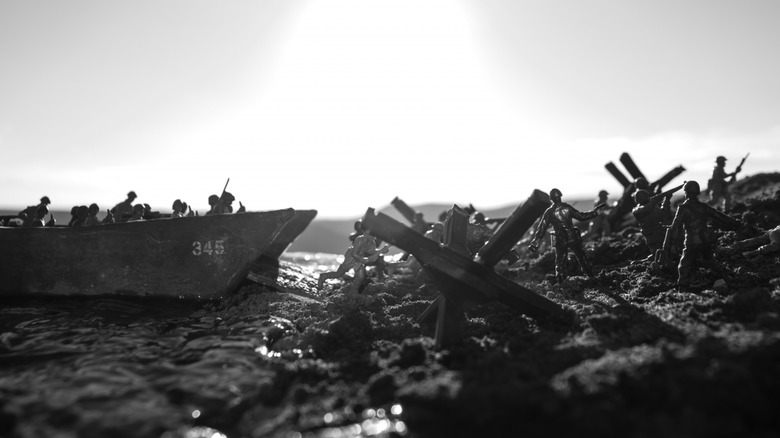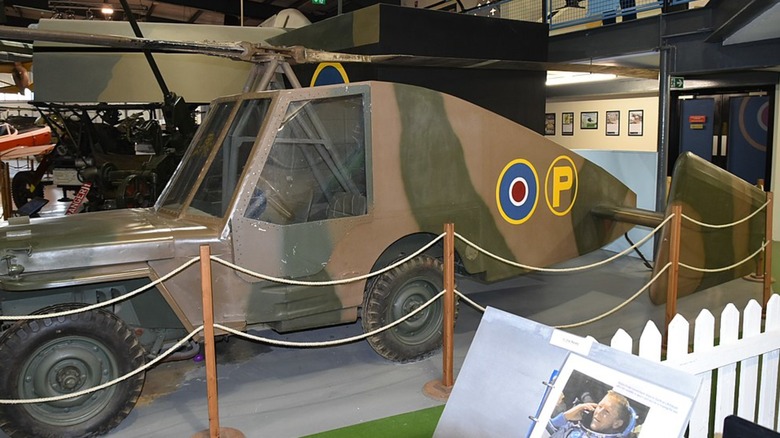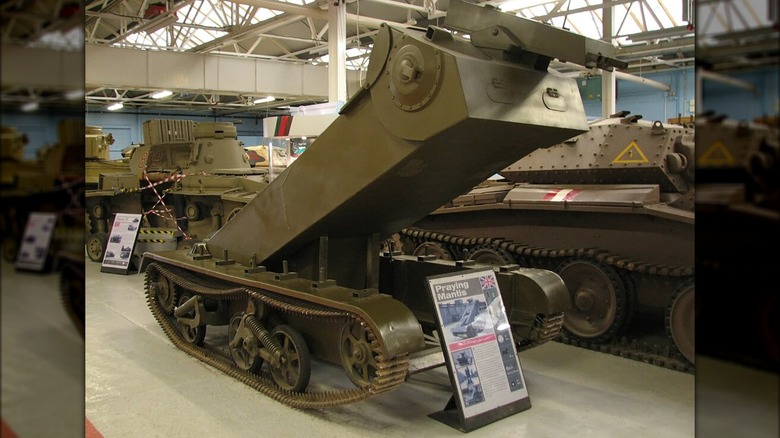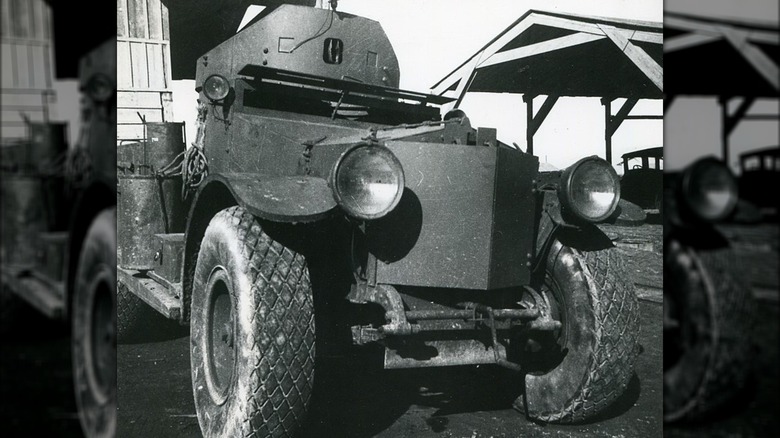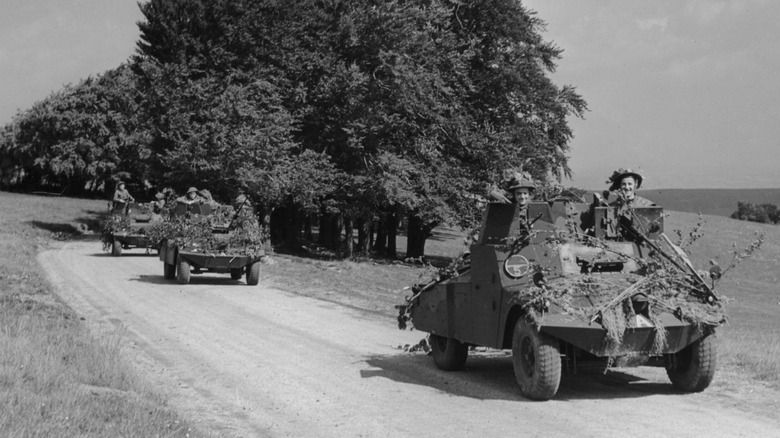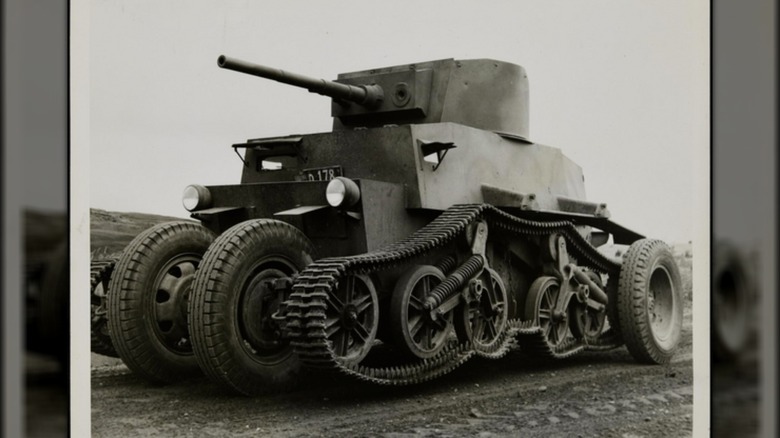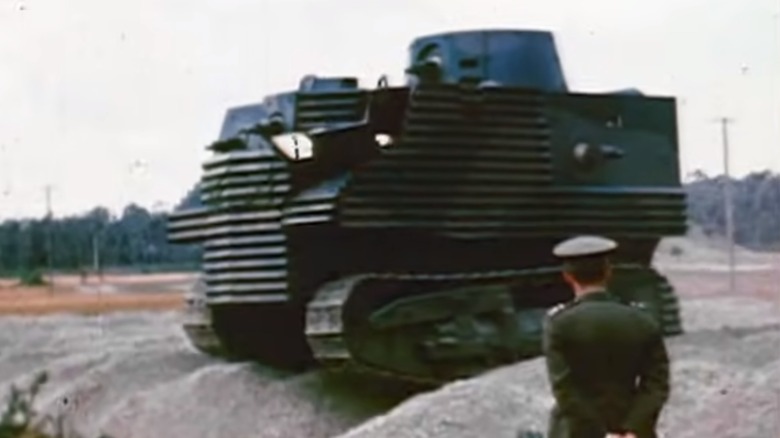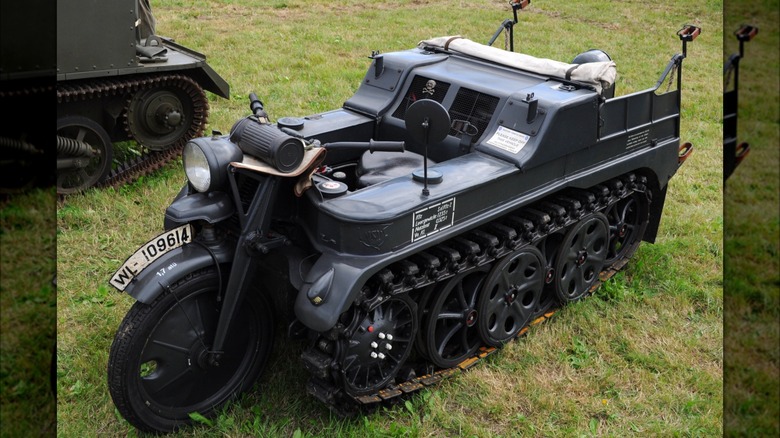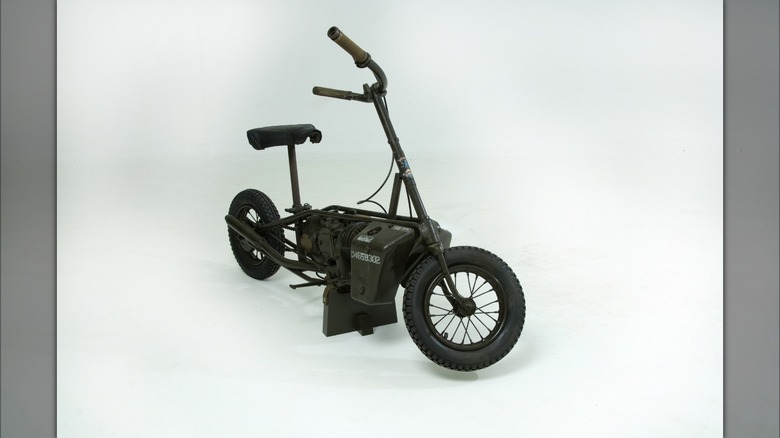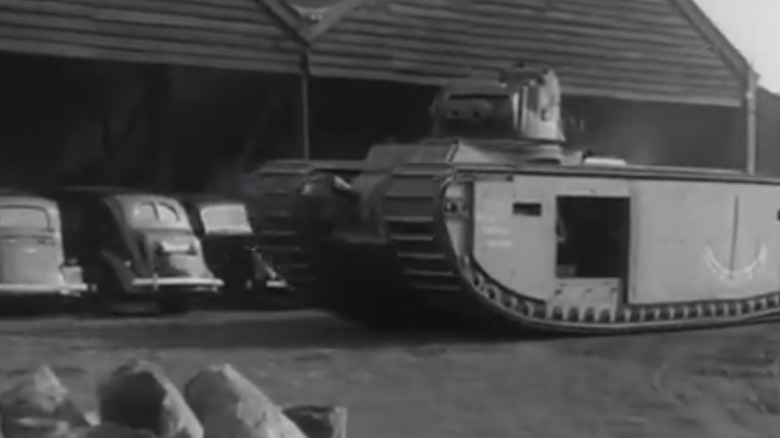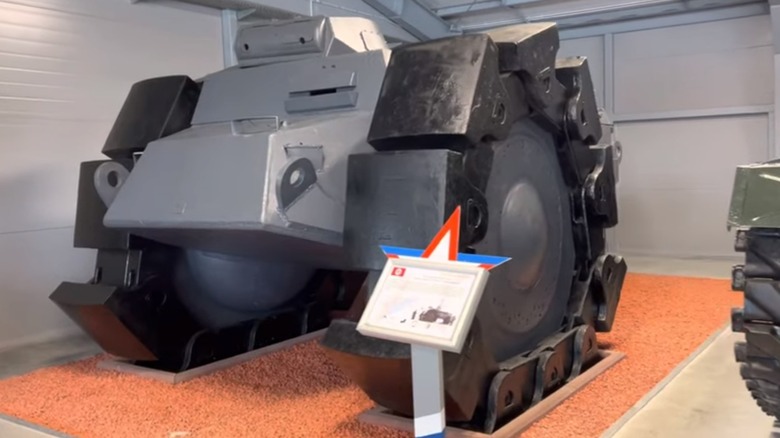10 Of The Strangest Vehicles Built During WW2
In times of war, especially as catastrophic as WWII, you need all hands on deck. This includes engineers and industrial designers. However, this can result in some interesting ideas bubbling up to the surface. During a war in which the economy is transformed toward total war production, everyone is working toward the same goal: producing materiel for the military. This means to continue making the things the troops already have and need more of, but also developing new weapons and machines to give them the upper hand over the enemy. In times before computer-aided drafting, this required a lot of trial and error in which building prototypes was the only way to find out if a new design would work.
Many prototypes went on to be some of the most useful tools of the soldier while others faded into obscurity. And without trying some new ideas, we would never have learned out which ones were best. Another facet is pushing the envelope to create the unexpected in another way to gain an edge over the adversary. This sometimes led to new armaments or transport vehicles that appeared odd or unusual. Even the first tank in WWI was a highly unorthodox machine, even though it went on to be a most successful piece of kit. But considering the extraordinary number of designs that made it to the prototype phase in this era, these 10 vehicles are among the strangest.
Hafner Rotabuggy
Sometimes the best way to develop a new machine is to repurpose an existing one. This takes away some of the developmental guesswork as part of it is ready to use from off-the-shelf parts and supplies. But then again, this does not always work. Such is the case of the Hafner Rotabuggy.
The idea of flying behind enemy lines and having your soldiers equipped with means of transportation has been a working concept that continues to be studied today. Paratroopers have been dropped from airplanes with bicycles, but having a more capable vehicle would provide obvious benefits. To that end, some clever gents in the U.K. devised a way to fit a rotary wing to the then-new Willys Jeep, enabling soldiers to fly it into battle and be able to drive it using its off-road capabilities on rough terrain. The rotor assembly was unpowered, making it an autogyro. This concept meant for the Rotabuggy to be airdropped onto a target with the rotor allowing for a slowed and controlled freefall, much like what happens when a helicopter loses power. Other tests were completed that involved towing the Rotabuggy up to a speed that would enable it to take flight. These were successful but with less than desirable results. The development of Jeep-carrying gliders and other designs prevented this from making it into production.
[Featured image by Alec Wilson via Wikimedia Commons | Cropped and scaled | CC BY 2.0]
Praying Mantis
You might question what a WWII-era military vehicle has to do with one of the coolest specimens of the insect world, the Praying Mantis. But with one look at this machine, the naming will become quite clear. It was built on the chassis of the British Universal Carrier, which was a small and lightly armored personnel carrier powered by a Ford Flathead V8 engine. A driver sat up front with the gunner in a control box laying prone with foot controls to operate the boom for the gun. The gun was put on a turret that could be raised nearly 12 feet in the air, providing a way to fire well above the soldiers within the unit while staying out of harm's way themselves.
This novel idea had some good points for its design and potential advantages in battle. However, in testing, it was found to be lacking in many ways. Users found the controls difficult to operate, making it a frustrating weapon to use. Furthermore, with the turret fully extended, the recoil tended to cause a lot of rocking and swaying, leaving its operators feeling seasick from the motion. The Mantis would not make it past the testing stage, though some of the ideas from this concept would influence later successful designs.
[Featured image by Hohum via Wikimedia Commons | Cropped and scaled | CC BY-SA 3.0]
Fordson Armored Car
Henry Ford grew up on a farm, and, as a result, he was keen to build equipment that could ease the load of the American farmer. His tractor division was first called Ford and Son, which was eventually shortened to Fordson. This name was also applied to a line of short-lived trucks made for farm duty. While the company made many trucks on the Model T assembly line, the Fordson was a much heavier truck with a two-ton payload capacity.
Some of the first armored vehicles to emerge in WWI were Rolls-Royce automobiles fitted with thick steel plating. These quickly proved to be inadequate for the increasingly terrifying and destructive ammunition that came from modern mechanized warfare, leading the British to hit the drafting table to create what would become the tank. Yet these armored cars still existed and would be used where applicable as long as they still worked.
In one of the stranger combinations of military hardware, the Royal Air Force had these two vehicles fused in Egypt around 1940. The armored body taken from the original Rolls-Royce chassis was dropped onto a Fordson chassis to make an armored truck with a heavy-duty chassis and robust suspension. The cars were worn out by that time but still had decent armored plating. Some modifications had to be made to the Fordson to accommodate the body, but most of it remained intact. The end result of this combination was an odd vehicle that looked typical of WWI machinery but was being used in many areas around the Gulf of Aden, finally being retired in 1943 when 4WD GMC Otters arrived.
Beaverette
When the British made the decision to withdraw expeditionary forces from Dunkirk as the Germans advanced through France in 1940, they had precious little time to execute the operation. This meant they had to leave behind a significant quantity of machinery and armament behind, including vehicles. Having lost much and needing to regroup for an expected German invasion, the British sought to make military vehicles to protect its coast quickly. One was created by Lord Beaverbrook, an important member of Winston Churchill's wartime administration, and immediately put into production.
This vehicle utilized an existing chassis from the Standard Motor Company with a healthy dose of armor plating affixed to the body. The vehicle would become known as the Beaverette, and nearly 3,000 were built. It was not a highly capable vehicle, and its 14-horsepower 1.8-liter engine made it extremely slow. Early models only received armor on the sides, leaving the front of it looking like most cars of the late-30s, with a narrow hood and curved fenders. The weight of the armor also made it difficult to drive, especially in a situation requiring a quick retreat. It also had terrible visibility owing to the only view provided by slots on the front and side.
Later editions received full armor plating that completely enclosed the engine compartment and provided a roof. Though many of the various versions were built, they were also put into service almost exclusively for border patrol in Britain and Northern Ireland. Records show that it never made it across the English Channel to fight, and that is probably for the best.
Schofield tank
While New Zealand's position as a relatively small island in the southern Pacific Ocean offered it plentiful naturally defensive positions, the speed and ferocity with which Imperial Japan sought conquest over Pacific nations mean they had to be prepared for the worst. Despite strong ties to the U.K., it was unlikely they could rely on them for any military hardware as that island nation was not only distant but busy protecting itself from a continental threat. Therefore, New Zealanders got to work creating some homegrown defensive machines to keep their borders secure.
Using parts and materials already available to the islanders, E.J. Schofield of General Motors Wellington developed a tank that used the chassis of a GM truck as its base. However, it proved to be an eccentric design. Added to the stock truck chassis were elements from a light-tracked vehicle that were installed in addition to the standard truck wheels. With this design, the tank — a term used rather lightly — could be driven over rough terrain on its tracks or switched to drive over roads with its tires. Power came from a 30-horsepower 6-cylinder engine which only allowed for speeds up to about 26 mph.
The Schofield only existed as a prototype. More military vehicles and equipment started arriving from Allied sources, primarily the U.S. troops, in 1943, negating the need for this odd contraption. It was scrapped sometime after the end of the war.
Bob Semple tank
The prelude to WWII in New Zealand spurred tank development by the Kiwis. Another project to arm and equip the New Zealand Army was spearheaded by Bob Semple, the Minister for Public Works at the time. With a looming invasion by Japan on the horizon and no effective armored force on the island, Semple sought to alter some existing vehicles with armor and guns to create an effective armored weapon.
Having seen a tractor converted into a tank before – it was likely the American Disston tank – Semple got to work creating one of his own with a Caterpillar track-driven D8 tractor, and the help of engineers and mechanics to build a prototype in a workshop of the Public Works Department. Relatively few modifications were made to the tractor itself, beyond the moving of controls, extending the track a bit, and tweaking the suspension. A body of armored steel was constructed to bolt onto the chassis of the tractor, with a plywood mock-up built to test-fit everything first. It was meant to have a 37 mm cannon in the turret, but supply issues meant that they could not obtain one. Instead, the vehicle was equipped with two machine guns, with an additional four guns mounted on all sides. In addition to the armor of the body of the tank, corrugated steel was added to the exterior to deflect machine gun fire with an armor system that was "severely tested."
In some publicity events, Semple displayed the tank in an effort to raise spirits and bolster the morale of the citizens. He instead received ridicule for the interesting-looking tank. It was not approved for production and was later used as a political tool for Semple's adversaries to oust him from government.
NSU Sd. Kfz. 2 Kettenkrad
Light mobility vehicles were in short supply during WWII. However, having the ability to get a small number of troops or light supplies quickly around a battlefield can be crucial to successful operations. The Jeep is partially credited for doing this for the Allies, but the Germans had something that worked as well on an even smaller scale. NSU began building motorcycles in Germany in 1901, becoming one of the largest manufacturers in the world. It was also heavily involved in war production and put its small vehicle expertise to use.
The Sd. Kfz. 2 Kettenkrad combined the agility of a motorcycle with the toughness of a tank. It looked like a motorcycle up front with a single wheel and handlebars but featured small tracks to propel it in the rear. It could carry a driver and two passengers as well as carry supplies or tow a small trailer. With the tracks driving it, it could tackle nearly any terrain without ever getting stuck. The engine was an Opel 1.4-liter 4-cylinder which would have had ample power to get it to an impressive top speed of 50 mph. At low speeds on rough terrain, the front wheel helped to guide with steering, but in other situations, the tracks accomplished directional movement with differential braking, much like any other tank.
The Kettenkrad is among the strangest of WWII vehicles, but, unlike many others, it was a successful design, and thousands were produced. It was especially popular in North African operations where the tracks provided excellent traction on sand. Furthermore, as many of these were made, plenty remain and can be purchased for use on private land today.
Welbike
Paratroopers performed a crucial role for the Allies when going in to liberate France. Without thousands of soldiers dropping in behind enemy lines to disrupt communication, logistics, and generally divert attention from the Normandy beaches, Operation Overlord may not have succeeded. With the paratroopers were also dropped supplies. This came in the form of firearms, ammunition, medical supplies, food, and communication gear. Among transportation supplies dropped were compact, foldable motorcycles called Welbikes.
When the war came to Britain, no form of transportation that could be dropped from an airplane existed. But by the invasion of Normandy in 1943, thousands of Welbikes had been built. A Welbike was a highly compact motorcycle that could be stowed in a drop tube with its handlebars folded down. A soldier could unpack and have his Welbike on the move in as little as 11 seconds, giving him near instant mobility that could quickly get him in position or ready to relay messages. The engine was a six cubic inch two-stroke affair that could get it up to 30 mph and an overall distance of 90 miles on one tank. To keep it compact, the fuel tank was mounted within the very low frame, and was meant to be pressurized to negate the need for a fuel pump. A small hand pump cam attached to the frame.
This little ingenious bike served a crucial role in freeing Europe from tyranny. It also had a civilian life after the war. With its fortunes floundering, American motorcycle company Indian began importing them and sold a version of them for many years as the Papoose.
TOG1
Although the tanks and other heavy equipment of WWI were long obsolete by the time Germany invaded Poland, some designers in England sought to revive some old plans. The designers of the original Mk I tank of WWI as a group were often known as "The Old Gang." This latest creation paid homage to them by being called the TOG1. Its unique design and tracks are a direct link back to this original design.
The TOG1 features huge tracks that go around the entire hull with no suspension just as did the original, but was also a major flaw in its design. But like the original, the TOG1 was being built specifically to overcome trenches on the battlefield as the design phase began only while officials saw war on the horizon and had not yet begun. Propulsion came courtesy of an electromechanical system with a 600 hp diesel engine spinning a generator wired to electric motors. This system didn't perform and was replaced with a hydraulic drive.
Two TOG1s were built and followed up by a TOG2, with plans for an utterly massive TOG Citadel never moving to the next phase. Development continued until 1943, and, by that time, it was obvious that entrenched positions with little movement would not be a defining characteristic of this war as it was for the last. Therefore, the program ended and fell into obscurity.
Alkett VsKfz 617 / NK-101 Minenräumer
Mines were a significant problem during WWII, and efforts were put forth by both sides to counter and remediate the problem. Among the solutions for clearing the minefields is the Alkett VsKfz 617 / NK-101 Minenräumer, created by Germany in 1942.
This gargantuan vehicle looks more like an armored tractor than anything, although that is not far from being accurate. It is built with a three-wheeled chassis operated by two people, a driver and a gunner. A Panzer I turret was mounted to the top with two machine guns for defensive purposes, but the hull was also made from steel plating up to 40mm thick. It was meant to go in at the front of a strike force to clear a path for the rest of the equipment and infantry to follow in its path. Therefore, it had to be highly resilient against direct fire. It featured two large drive wheels up front to pull the machine along with a third one trailing in the rear. A Maybach V12 situated in the middle provided power, and steering was accomplished by braking one wheel.
The way this 50-ton machine was meant to clear mines was to roll over them. The wheels are covered with steel plates that, when rotated to the lowest position, would be arranged in threes to provide the maximum area where they can make contact with a mine trigger, safely absorbing the blast. Although it was slow and lumbering, it appeared as though it would be effective in clearing mines. However, the proliferation of artillery in the field that could easily rip a hole in it prevented more than just a prototype from being constructed. It still exists at the Kubinka Tank Museum in Russia.
